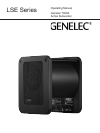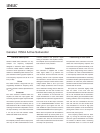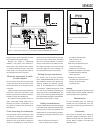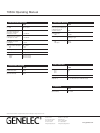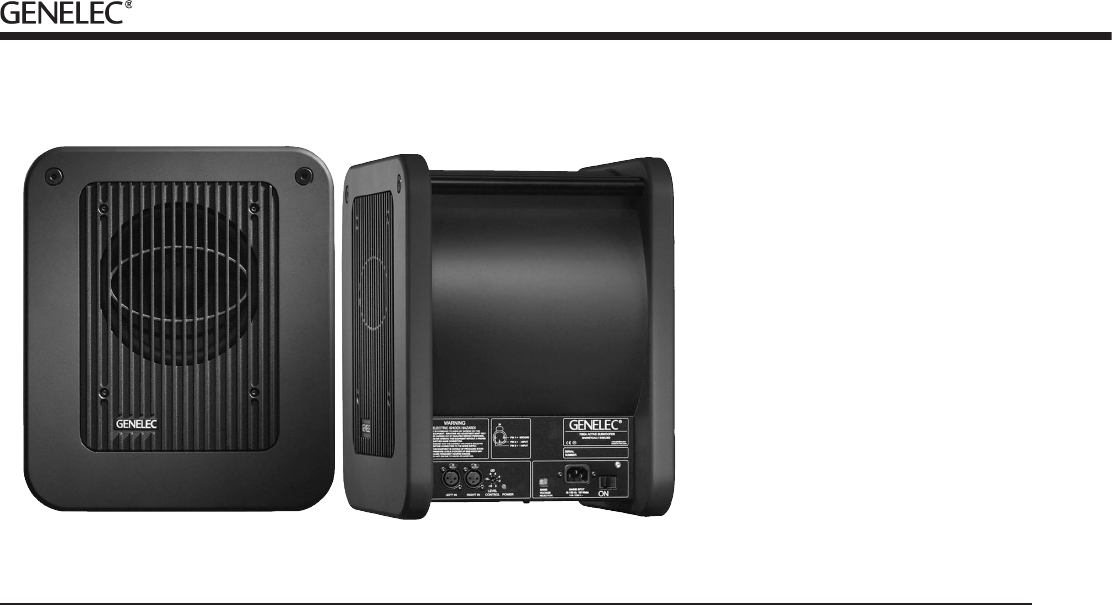
General description
Genelec 7050A active subwoofer is a very
compact low frequency loudspeaker,
designed to extend the bass reproduction
of Genelec 1029A, 2029A or 2029B active
monitors in stereo applications. Adding the
7050A to a 1029/2029 system creates a com-
pact neareld monitoring system capable of
a at frequency response from 38 Hz to 20
kHz (± 3 dB).
Driver
The 7050A contains a single 200 mm (8”)
magnetically shielded low frequency driver,
housed in Genelec Laminar Spiral Enclosure
TM
(LSE
TM
).
Crossover
The active crossover contained within the
amplier unit lters the input signals. This
accurately rejects the higher frequencies that
the monitors reproduce, and allows the lower
frequencies to pass. The sensitivity can be
attenuated from 0 dB to -18 dB for easy level
matching with the main loudspeakers. Due to
the input sensitivity of the 7050A subwoofer
it can only be used with Genelec 1029A,
2029A and 2029B active monitors.
Amplifier
The amplier produces 70 W of output power,
with very low THD and IM distortion. Driver
overload protection and power-on signal
muting is included in the amplier circuitry.
The amplier also incorporates thermal over-
load and short circuit protection.
Installation
The subwoofer is supplied with a mains
cable, signal cables to go between the
main monitors and the subwoofer and this
operating manual. Once unpacked inspect
the subwoofer to ensure that it has not been
damaged in transport. Check that the mains
voltage selector switch is set to your local
mains voltage (Subwoofers sold in Europe
have a xed 230 V setting). Ensure that both
the subwoofer and the main monitors are
switched off before making any connections.
Audio connections to the subwoofer are
made with balanced 1/4" Jack / XLR cables
supplied with the subwoofer. Signals from the
source are fed to the XLR input connectors
of the 1029A/2029A/2029B monitors. The
7050A gets its input signal from the 1/4"
Jack "SUB OUT" output connectors of the the
1029A/2029A/2029B monitors (see Figure 1).
When used in conjunction with the 7050A the
"BASS ROLL-OFF" dip switch (switch 2) on
the 1029A/2029A/2029B should be switched
to position "ON". Once all connections have
been made, the subwoofer and main monitors
are ready to be powered up.
Positioning in the room
The placement of the subwoofer in the room
affects the overall frequency response and
sound level of the system dramatically, as at
low frequencies the effects of the room are
strong. Even a slight change in the subwoof-
er's location can make a marked difference
in the frequency balance and often a patient
and methodical experimentation and testing
is needed to nd the optimum placement. The
placement will affect the phase difference
between the main monitors and the subwoofer
and the bass roll-off rate.
First place the subwoofer slightly offset
from the center of the front wall. The
recommended distance to the wall is less than
90 cm / 36" measured from the subwoofer's
driver. This position gives increased acoustic
loading (and SPL) due to the proximity of the
front wall and oor. Cancellations from the
front wall and oor are also avoided. Front
wall cancellation for the 85 Hz high pass
ltered main speakers can be eliminated by
placing them at least 110 cm / 43" away from
the front wall (see Figure 2).
If the frequency balance does not seem
right, try moving the subwoofer slightly to
the left or right so that different room modes
are excited at different levels. Positioning
the subwoofer close to a corner will boost
Genelec 7050A Active Subwoofer



